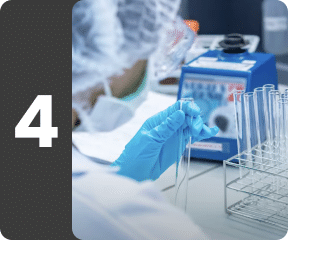FSH, LH & Prolactin
Understanding FSH, LH & Prolactin
What is FSH, LH & Prolactin?
The Hormonal Profile includes three important hormones: Follicle-Stimulating Hormone (FSH), Luteinizing Hormone (LH), and Prolactin. These hormones help control reproductive functions and milk production. This test helps in identifying and managing hormonal issues and fertility problems.
FSH, LH, and Prolactin are all produced in the anterior pituitary gland. These hormones play a key role in reproductive health and general well-being. Measuring their levels is often the first step in checking fertility in both men and women or finding possible hormonal problems.
- Follicle-Stimulating Hormone (FSH): This hormone helps in the growth of eggs and regular menstrual cycles in women and supports sperm production in men. Abnormal levels can lead to issues like irregular periods, fertility problems, PCOS, and pituitary disorders.
- Luteinizing Hormone (LH): This hormone works with FSH. It triggers ovulation in women and supports testosterone production in men. Imbalanced LH levels can also cause fertility and hormonal problems.
- Prolactin: This hormone helps in the development of breasts and milk production in women. It also affects the menstrual cycle. High prolactin levels can cause irregular periods, fertility problems, and conditions like galactorrhea (milk production without pregnancy) and pituitary tumors (prolactinomas).
In women, doctors may suggest this test if you have irregular or heavy periods, PCOS/PCOD, trouble conceiving, or suspected issues with the pituitary or hypothalamus. In men, it may be done if there are signs of low testosterone, such as low sex drive or reduced muscle mass.
Fasting is required before this test. Do not eat or drink anything except water for 8–12 hours before the test. For women, the ideal time to take the sample is on the second or third day of the menstrual cycle. Your doctor may ask you to stop certain medicines like birth control pills or Biotin (Vitamin B7), as they can affect the test results. Prolactin levels can change during the day and are influenced by stress, exercise, and sleep. So, your doctor may recommend repeat tests to confirm the results.
Test result ranges are approximate and may differ slightly between labs depending on the methodology and laboratory guidelines. Talk to your doctor about your specific test results. The results will help them determine your medical condition and formulate your treatment plan.
What is FSH, LH & Prolactin used for?
The FSH, LH & Prolactin test is done:
- Check fertility issues in men and women.
- Investigate irregular or absent periods (amenorrhea or oligomenorrhea).
- Find the cause of unusual breast milk discharge (galactorrhea) in women who are not pregnant.
- Understand low milk production in women after delivery.
- Diagnose problems or tumors in the pituitary gland, or diseases affecting the ovaries or testicles.
What does FSH, LH & Prolactin measure?
Contains 3 testsThe FSH, LH & Prolactin test measures levels of three hormones, namely follicle-stimulating hormone (FSH), luteinizing hormone (LH), and prolactin, that are critical for reproductive function in males and females. This hormonal test is conducted to address various issues associated with the process of ovulation, fertility, and reproductive organs.
These hormones are important for reproductive health. Their levels help doctors understand problems with ovulation, fertility, and hormone production. In children, these hormone levels are usually low. But as puberty starts, the brain produces a hormone called GnRH, which signals the pituitary gland to release FSH and LH into the blood.

Follicle Stimulating Hormone
The Follicle Stimulating Hormone test measures the level of FSH in your body. FSH is produced and subsequently released into the blood by the pituitary gland. Its production is controlled by a feedback mechanism involving a hormone situated in the hypothalamus in the brain. The released FSH travels through your blood and then attaches to receptors in the ovaries and testes. It exerts functional effects on the reproductive organs, such as sexual development, puberty, and maturation. FSH levels vary throughout the menstrual cycle in response to estradiol and progesterone. Any disruption or issue in this feedback mechanism can prevent the normal function of the testicles or ovaries. Thus, determining its level provides crucial information regarding your health.
Know more about Follicle Stimulating Hormone

Serum Prolactin
The Serum Prolactin test measures how much prolactin hormone is in the blood. During pregnancy, prolactin works along with estrogen and progesterone to prepare the body for breastfeeding. After delivery, prolactin helps start and maintain milk production. If a woman does not breastfeed, her prolactin levels drop soon after birth.
Besides pregnancy, the most common cause of high prolactin is a prolactinoma. It is a non-cancerous tumor in the pituitary gland. These tumors are more common in women but can also occur in men. If the tumor becomes large, it may press on the optic nerve, causing headaches and vision problems. It can also affect the production of other hormones.
Know more about Serum Prolactin

Luteinising Hormone
The Luteinising Hormone test determines the level of luteinizing hormone that promotes the functioning of the gonads, i.e., testes in men and ovaries in women. LH is produced by the pituitary gland, a pea-sized gland situated at the base of the brain. The production and release of LH are controlled by a system known as the hypothalamic-pituitary-gonadal axis. A hormone called GnRH is released from the hypothalamus of the brain and binds to the cell receptors in the anterior pituitary gland, which in turn prompts the synthesis and release of luteinizing hormone. LH then travels across the blood and attaches to its target cells in the testes in men and ovaries in women to facilitate optimal sexual and reproductive activities.
Know more about Luteinising Hormone
Interpreting FSH, LH & Prolactin results
Interpretations
The reference range of FSH is age- and gender-specific. As for women, the reference range is phase-specific for the menstrual cycle.
The reference range for follicle-stimulating hormone (FSH) is as follows (3rd generation immunochemiluminescence assay):
Females
· Age 0-7 years: <6.7 mIU/mL
· Age 8 years to adult:
· Follicular phase: 3.1-7.9 mIU/mL
· Ovulation peak: 2.3-18.5 mIU/mL
· Luteal phase: 1.4-5.5 mIU/mL
· Postmenopausal: 30.6-106.3 mIU/mL
Males
· Age 0-7 years: <6.7 mIU/mL
· Age 8 years-adult:1.3-19.3 mIU/mL
The following values are considered to be normal, LH blood levels measured in international units per liter (IU/L):
Women:
· Follicular phase of the menstrual cycle: 1.9 to 12.5 IU/L
· LH surge: 8.7 to 76.3 IU/L
· Luteal phase of the menstrual cycle: 0.5 to 16.9 IU/L
· Pregnancy: less than 1.5 IU/L
· Post-menopause: 15.9 to 54.0 IU/L
· Women using contraceptives: 0.7 to 5.6 IU/L
Men:
· Age group of 20 and 70 years: 0.7 to 7.9 IU/L
· >70 years of age: 3.1 to 34.0 IU/L
The following values are considered to be normal, prolactin blood levels measured in international units per liter (ng/mL):
Patients (Age) Reference Range(s)
|
Males ≤ 18 Years |
|
|
Tanner Stage 1 (< 9.8 Years) Tanner Stage 2 (9.8 - 14.5 Years) Tanner Stage 3 (10.7 - 15.4 Years) Tanner Stage 4 (11.8 - 16.2 Years) Tanner Stage 5 (12.8 - 17.3 Years) Males > 18 Years
|
< 10 ng/mL < 6.1 ng/mL < 6.1 ng/mL 2.8 - 11.0 ng/mL 2.8 - 11.0 ng/mL
2.10 - 17.70 ng/mL |
|
In Females ≤ 18 Years |
|
|
Tanner Stage I (< 9.2 Years) |
3.6 - 12.0 ng/mL |
|
Tanner Stage 2 (9.2 - 13.7 Years) |
2.6 - 18.0 ng/mL |
|
Tanner Stage 3 (10 - 14.4 Years) |
2.6 - 18.0 ng/mL |
|
Tanner Stage 4 (10.7 - 15.6 Years) |
3.2 - 20.0 ng/mL |
|
Tanner Stage 5 (11.8 - 18.6 Years) |
3.2 - 20.0 ng/mL |
|
Adult Females Non Pregnant |
2.80 - 29.20 ng/mL |
|
Pregnant Post Menopausal |
9.70 - 208.50 ng/mL 1.80 - 20.30 ng/mL |
The reference range may vary from lab to lab*
Frequently Asked Questions about FSH, LH & Prolactin
Q. Why is the FSH, LH & Prolactin test done?
Q. What are the symptoms of hormonal imbalance in men and women?
Q. What factors can affect FSH, LH & Prolactin levels?
Q. Which factors can affect my FSH levels?
Q. What happens if FSH levels are high in women?
Q. What causes high FSH in men?
Q. What do low levels of FSH mean?
Q. Do FSH levels change during the menstrual cycle?
Q. Is prolactin hormone present in men?
Q. What is prolactinoma?
Q. What are the symptoms of prolactinoma?
Q. What happens if my prolactin levels are low?
Q. What foods can increase my prolactin levels?
Q. What conditions can increase LH levels?
Q. What happens when LH levels are high?
Q. What happens when LH levels are low?
Q. What foods increase levels of luteinizing hormone?
Q. Can lifestyle changes affect FSH, LH, and Prolactin levels?
Book a FSH, LH & Prolactin test at home near me





Other tests









